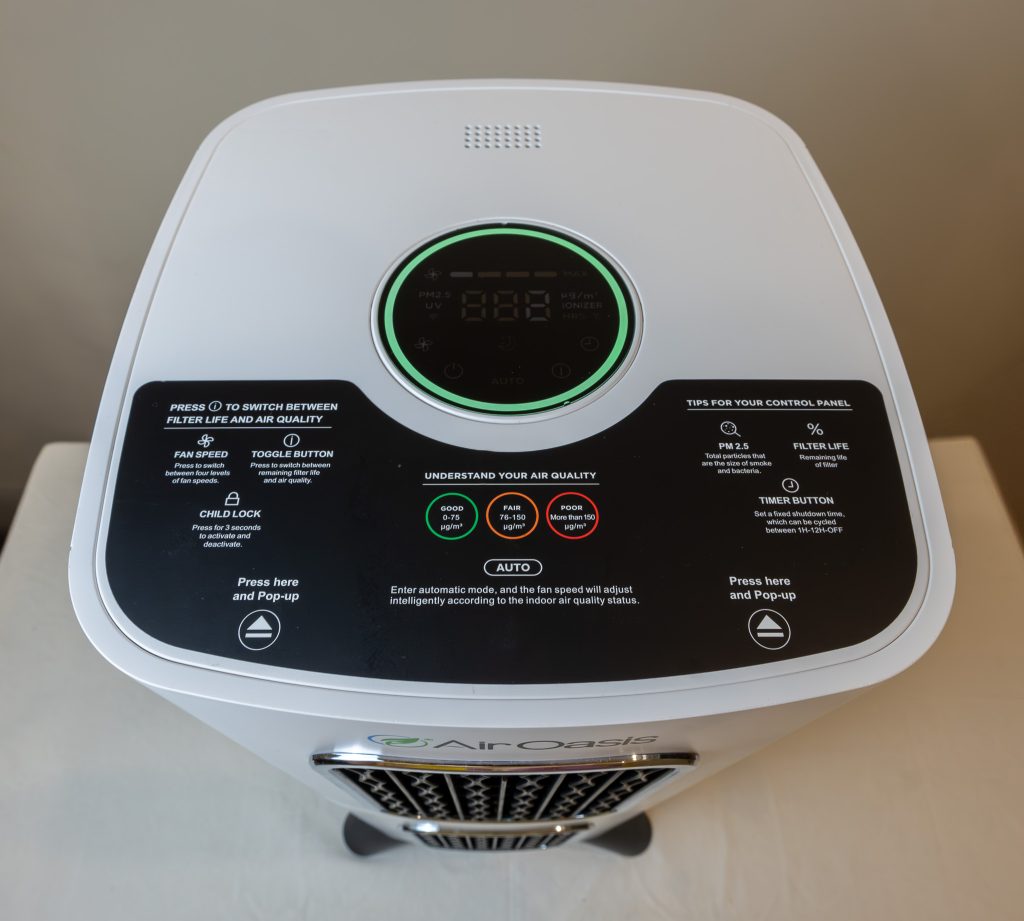Air Oasis – iAdaptAir 2.0 Review
Introduction
I wasn’t even looking for an air purifier.
Seriously. I’d been living in blissful ignorance for years, assuming that my slightly stale, suspiciously dusty apartment air was just part of adulting. I lit candles when things got funky, cracked a window when my allergies flared, and chalked up any congestion to “city living.” And then came the mold.
A small, barely visible patch on my bedroom ceiling after an early spring storm. The landlord said it was nothing to worry about. My sinuses strongly disagreed.
I started waking up with pounding headaches, itchy eyes, and this low-key brain fog that felt like I was constantly two coffees behind reality. That’s when a friend—an allergy-sensitive, tech-obsessed nurse practitioner—blurted out mid-brunch: “You need the Air Oasis iAdaptAir 2.0. Trust me.”
 The name alone sounded like something NASA might use to purify air on Mars. Apparently, it was getting buzz in the health forums she frequented, especially among folks with Chronic Inflammatory Response Syndrome (CIRS), mold sensitivities, and mystery allergies. It had been launched just a few months earlier and was making waves for its five-layer filtration and whisper-quiet performance.
The name alone sounded like something NASA might use to purify air on Mars. Apparently, it was getting buzz in the health forums she frequented, especially among folks with Chronic Inflammatory Response Syndrome (CIRS), mold sensitivities, and mystery allergies. It had been launched just a few months earlier and was making waves for its five-layer filtration and whisper-quiet performance.
Made by a Texas-based company called Air Oasis, the iAdaptAir 2.0 was even endorsed by Dr. Ritchie Shoemaker—the guy who literally defined CIRS. According to some Redditors, this purifier had “cured” their indoor air woes, and users recovering from wildfires, water damage, and post-hurricane mold swore by it. I was intrigued. Skeptical, but intrigued.
I wasn’t a gadget-head or wellness junkie, but I was tired of feeling like I lived in a petri dish. So, one foggy Tuesday afternoon, I did something very unlike me: I dropped over $650 on clean air.
Technical
Powerful Multi-Stage Filtration You Can Actually Feel

Where some purifiers focus on one type of contaminant (say, just dust or just odors), the iAdaptAir 2.0 takes a more comprehensive approach. The HEPA filter captures tiny particles like pollen, dander, and mold spores, while the activated carbon targets gaseous pollutants and household odors. The UV-C light adds another layer of protection by neutralizing airborne bacteria and viruses, and the ionizer helps particles clump together so they’re more easily trapped.
In real-world terms, that means cleaner-smelling air, fewer allergy flare-ups, and potentially fewer sick days, especially in households with kids, pets, or shared living spaces.
Smart Sensing That Takes the Guesswork Out of Clean Air
One of the most convenient features of the iAdaptAir 2.0 is its ability to monitor and respond to air quality automatically. Using a built-in PM2.5 sensor, the unit constantly evaluates the air in your space and adjusts the fan speed accordingly. If you’ve ever used a purifier that either runs full blast 24/7 or sits idle until you intervene, you’ll appreciate just how seamless this is.
For example, during normal, clean-air conditions, the iAdaptAir 2.0 stays whisper-quiet. But as soon as it detects a sudden change, it ramps up within seconds. You don’t have to touch a thing. This smart automation not only saves energy but ensures your air quality is always being optimized without your involvement.
App Control and Air Quality Monitoring from Anywhere
The companion app, available for both iOS and Android, allows you to monitor and control your purifier remotely. That’s a practical benefit if you want to kick it on before heading home after a commute or check indoor air levels while you’re on vacation. The app displays real-time air quality readings, including particle counts, and offers insights into how your environment is trending over time.
What sets this experience apart is how informative (and a bit addictive) it becomes. You might notice how cooking impacts your air for an hour or how pollen spikes during certain times of day. This kind of awareness helps you make smarter decisions about when to ventilate your space, or when to keep the windows shut.
Compact but Effective: Designed for Real Homes
Despite all its power, the iAdaptAir 2.0 is surprisingly compact and easy to place. It’s available in three sizes (small, medium, and large), with the medium being ideal for bedrooms, living rooms, or home offices up to about 500 square feet. If you’re used to clunky purifiers that dominate a space, this will feel refreshingly minimalist. It’s designed to blend in, not take over.
And while it’s not intended to cover an entire house on its own, placing one in your most-used room delivers noticeable results. If you have a larger home, multiple units can work in tandem.
A Quick Word on Noise and Maintenance
Noise-wise, the iAdaptAir 2.0 is a standout. On its lowest settings, it’s nearly silent—ideal for light sleepers. Even when ramping up during a purification “event,” it’s still quieter than a typical fan or AC unit. Maintenance is simple too: the filters are easy to swap (every 6–12 months, depending on usage), and the app notifies you when it’s time.
Compared to other purifiers I’ve tried, like the Blueair 211+ or the Dyson Pure Cool, the iAdaptAir 2.0 offers more holistic filtration with less manual tweaking. It’s less visually imposing than the Blueair, and more focused on pure purification than the Dyson, which often splits its attention between cooling and filtering.
Bottom Line: High-Tech Filtration Without the Fuss
If you’re looking for a purifier that doesn’t just boast specs but delivers real, daily-life benefits, the iAdaptAir 2.0 stands out. It’s powerful without being loud, smart without being complicated, and clean in both form and function. Whether you’re battling allergies, sensitive to smells, or just want healthier indoor air, it brings peace of mind—and cleaner lungs—without needing constant attention.
Experience

What amazed me was how quickly the atmosphere changed. In about 15 minutes, the haze had cleared, the burnt smell was gone, and I wasn’t coughing or dealing with watery eyes. It wasn’t just a cosmetic fix, it felt like the air itself had been reset. From that moment, I understood just how responsive and powerful the iAdaptAir could be.
Beyond the occasional culinary mishap, I started to notice more subtle benefits. Morning headaches I’d come to accept as routine? Gone. The usual sinus pressure that flared up around dust or pollen season? Significantly reduced. Even a persistent scratchy throat that I had chalked up to living in a dry climate seemed to vanish. After a week or so, I realized my apartment didn’t have a smell anymore. The kind of “nothingness” you only notice in high-end hotel rooms after housekeeping has done its magic.
One of the things I’ve come to appreciate most is how little I have to think about the iAdaptAir 2.0. It’s whisper-quiet at night, which has noticeably improved my sleep quality. The auto mode does an excellent job adjusting the fan speed based on changing air conditions, so I rarely need to fiddle with settings. When I’m away, the mobile app lets me keep an eye on indoor air quality in real time, and I’ll admit there’s something oddly satisfying about watching those particle count graphs dip and rise throughout the day.

That said, there are a few areas where the iAdaptAir 2.0 could be better. At $659, the upfront cost is undeniably steep—especially if you’re considering one for each room in a larger home. While the app itself runs smoothly now, the initial setup was finicky. It took me two tries to sync it with my Wi-Fi, which was a little frustrating. I also wish it supported smart home integration natively; as of now, there’s no direct compatibility with Alexa or Google Home. Lastly, while the design is clean, some of the plastic components feel a bit lightweight.
After living with it for a couple of months, the iAdaptAir 2.0 has become a core part of my home’s ecosystem. It doesn’t demand attention, and yet its impact is felt every day. From better sleep to fewer allergies and a generally fresher atmosphere, it’s one of those upgrades that fades into the background while continuously improving your environment. For those serious about indoor air quality and looking for a purifier that performs without fuss, it’s a solid investment—quirks and all.
Final Thoughts: Worth the Investment?
Here’s the thing: I didn’t buy this purifier to join the clean-air revolution. I just wanted to stop waking up feeling like I slept in a basement crawl space. But what I got was so much more than a symptom fix.
This machine changed how I think about my environment. About what I breathe every minute of every day. It made me realize that indoor air quality is fundamental. And now that I’ve experienced what truly clean air feels like, there’s no going back.
The Air Oasis iAdaptAir 2.0 may be pricey, but it earns every dollar. It’s powerful, intuitive, and made by a company that genuinely seems to care—not just about performance, but about the people using it. I love that it’s endorsed by serious medical experts and backed by real-world success stories from folks who were desperate for relief.
If you’re someone who struggles with allergies, mold, mystery symptoms, or just wants to make their home feel fresher, cleaner, and safer, I can’t recommend this enough.
It’s not just an air purifier. It’s a quiet, powerful little ally in the corner of my living room, and I’ve never breathed easier.
























